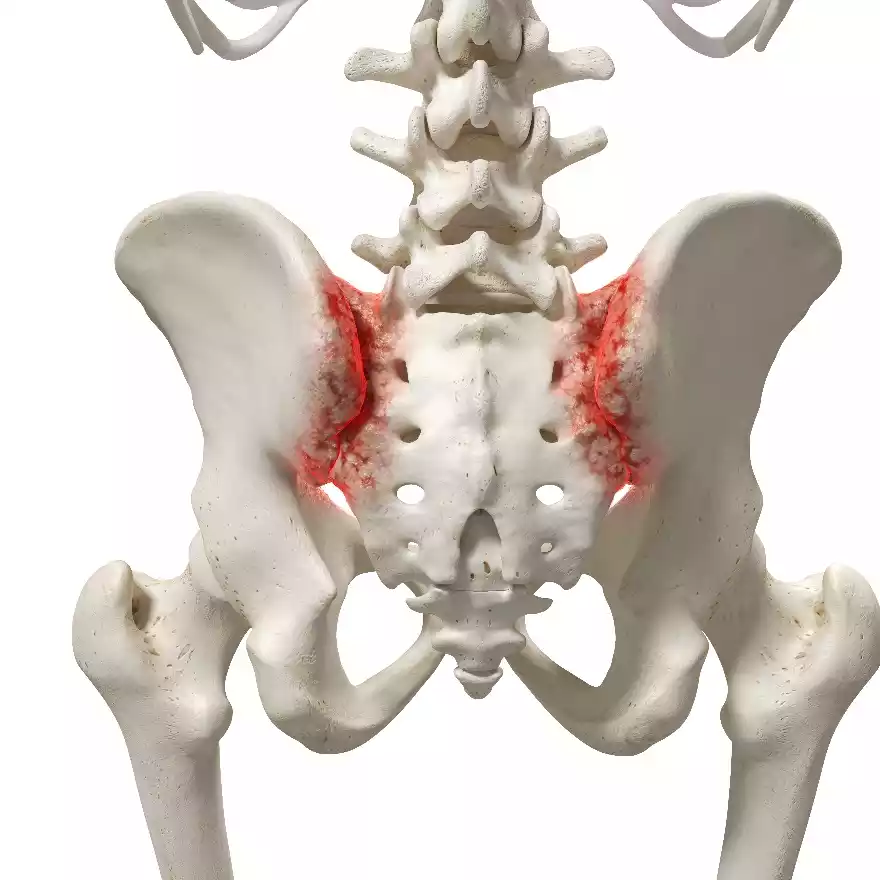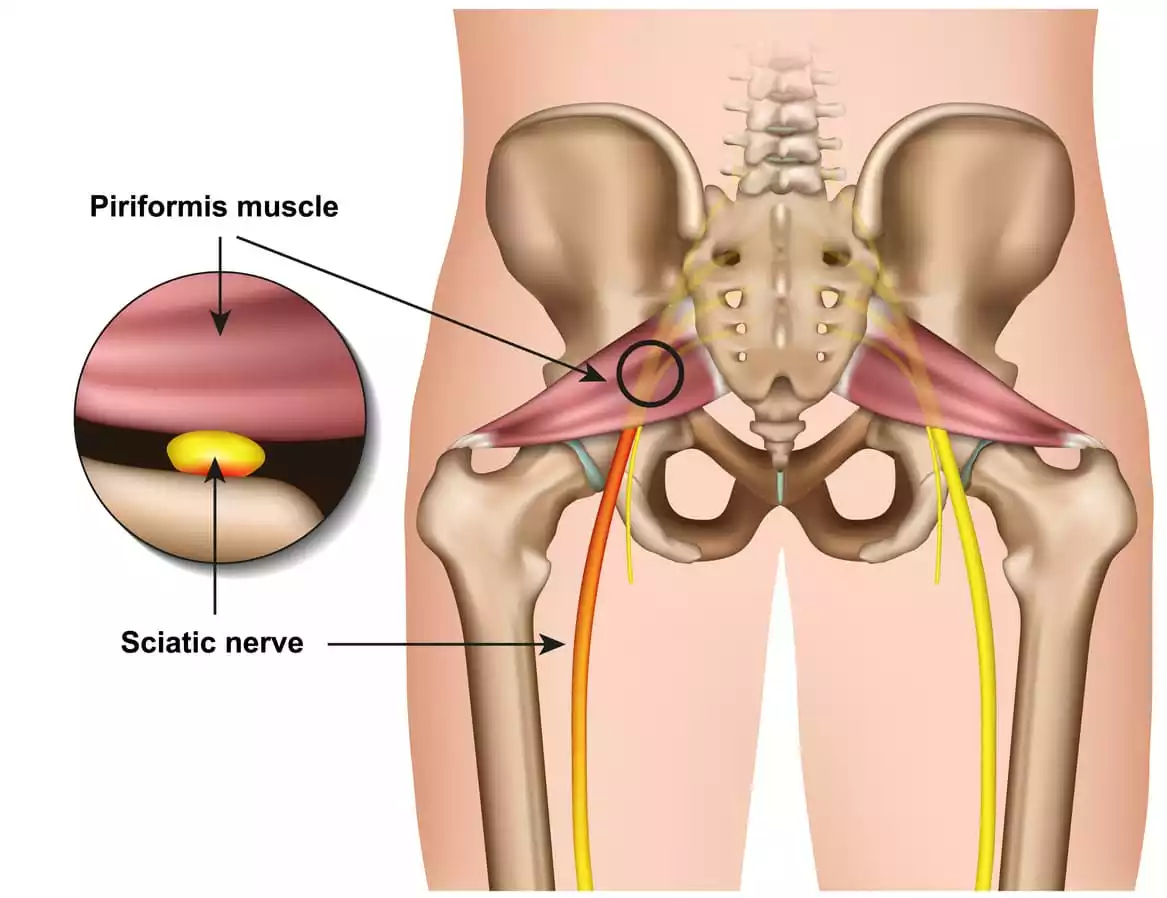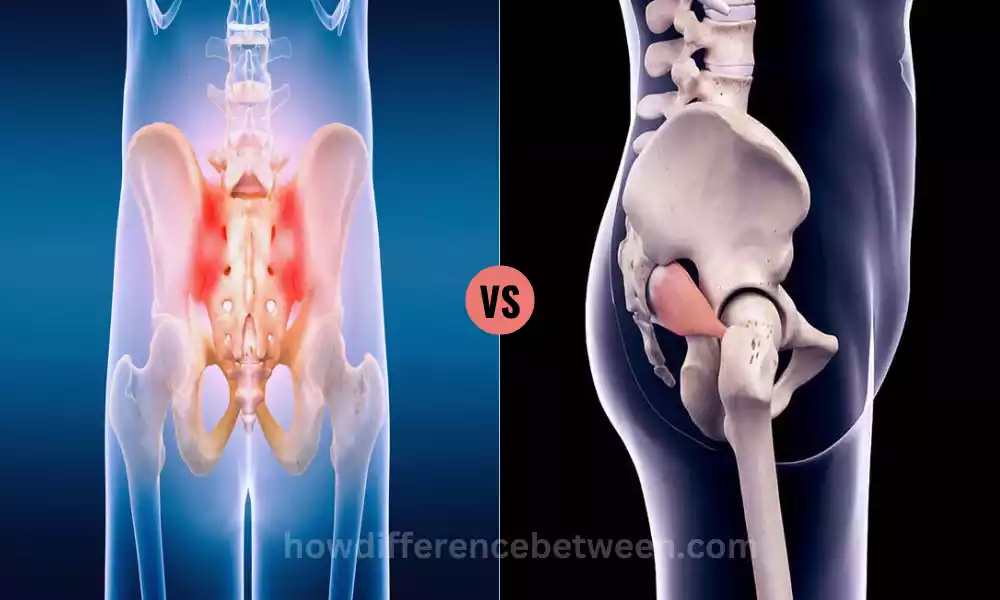SI Joint Pain and Piriformis Syndrome are two distinct yet interconnected conditions that can cause significant discomfort and hinder daily activities. The Sacroiliac (SI) joint, linking the spine to the pelvis, can be a source of pain when its normal functioning is disrupted.
On the other hand, Piriformis Syndrome arises from the tightness or spasms of the Piriformis muscle in the buttock region. Both conditions can lead to lower back pain, buttock pain, and even radiating discomfort down the leg. Understanding these conditions and their causes is crucial for effective management and improved quality of life.
What is Joint pain?

The Sacroiliac (SI) joint is a crucial point of connection in the human body, joining the sacrum (the triangular bone at the base of the spine) with the ilium, which is part of the pelvis. This joint plays a vital role in transmitting forces between the upper body and the legs, allowing for stability and movement.
Disruptions or imbalances in the SI joint can lead to SI joint pain, often characterized by discomfort in the lower back and buttocks. Understanding the significance of the SI joint is essential in comprehending conditions that affect its normal function.
Causes of SI Joint Pain
SI joint pain can arise from various underlying causes, often contributing to discomfort and reduced mobility. Common sources of SI joint pain can include:
- Muscle Imbalance: An imbalance in the muscles surrounding the SI joint can exert uneven pressure on the joint, leading to pain. Weakness or tightness in certain muscles can disrupt the joint’s stability.
- Trauma or Injury: Accidents, falls, or impacts to the pelvis can result in damage to the SI joint. Trauma to this area can lead to inflammation, pain, and discomfort.
- Repetitive Movements: Engaging in activities that involve repetitive movements of the lower back and hips can strain the SI joint over time. The continuous stress on the joint can contribute to pain and discomfort.
- Arthritis: Arthritis, particularly osteoarthritis or ankylosing spondylitis, can affect the SI joint. Inflammatory changes in the joint’s structure can lead to pain and limited range of motion.
- Pregnancy: During pregnancy, hormonal changes can cause ligaments to become more relaxed, potentially leading to increased stress on the SI joint. This can result in pregnancy-related SI joint pain.
- Inflammatory Conditions: Conditions such as psoriatic arthritis and certain types of inflammatory arthritis can affect the SI joint, leading to inflammation, pain, and stiffness.
- Infection: In rare cases, infections can impact the SI joint, causing pain and discomfort. Infection-related SI joint pain often requires prompt medical attention.
- Degenerative Changes: Degenerative changes in the spine and pelvis, such as degenerative disc disease, can also contribute to SI joint pain over time.
- Leg Length Discrepancy: When one leg is slightly longer than the other, it can lead to misalignment and uneven stress on the SI joint, potentially causing pain.
Understanding the potential causes of SI joint pain is essential for accurate diagnosis and effective management of this condition.
What is Piriformis Syndrome?

Piriformis Syndrome is a condition that stems from the Piriformis muscle, which is located in the buttock area. This muscle plays a role in stabilizing the hip joint and aiding in leg movement. When the Piriformis muscle becomes tight or experiences spasms, it can lead to a condition known as Piriformis Syndrome.
This syndrome often manifests as pain and discomfort in the buttocks, which may radiate down the leg. The symptoms of Piriformis Syndrome can closely mimic those of sciatica, as the sciatic nerve runs near the Piriformis muscle. Understanding this syndrome is crucial for recognizing and addressing buttock and leg pain that may not be solely related to other causes.
Causes of Piriformis Syndrome
Piriformis Syndrome can be attributed to various factors that affect the Piriformis muscle in the buttock region. Some common causes of Piriformis Syndrome include:
- Muscle Tightness and Spasms: The Piriformis muscle can become tight or experience spasms due to factors such as overuse, strain, or muscle imbalances. This tightness can lead to compression of the nearby sciatic nerve, causing pain.
- Anatomical Variation: In some individuals, the sciatic nerve may pass through or beneath the Piriformis muscle. Anatomical variations like this can increase the risk of nerve compression and the development of Piriformis Syndrome.
- Injury or Trauma: Direct impact to the buttocks or pelvis can injure the Piriformis muscle, leading to inflammation and spasms. Trauma can exacerbate muscle tightness and contribute to the development of the syndrome.
- Repetitive Strain: Engaging in activities that involve repetitive hip movements or excessive sitting can strain the Piriformis muscle, causing it to become tight and prone to spasms.
- Overuse of the Muscle: Athletes or individuals engaged in activities that involve repetitive hip rotation or flexion, such as running or cycling, can strain the Piriformis muscle and increase the risk of Piriformis Syndrome.
- Sedentary Lifestyle: Prolonged periods of sitting can weaken the muscles in the buttock region, including the Piriformis muscle. Weakness in this muscle can lead to imbalances and increased susceptibility to Piriformis Syndrome.
- Sciatic Nerve Irritation: Irritation of the sciatic nerve due to other underlying conditions, such as lumbar disc herniation, can contribute to muscle spasms and tightness in the Piriformis muscle.
- Postural Imbalances: Poor posture can lead to misalignment of the spine and pelvis, putting extra stress on the Piriformis muscle and potentially triggering the syndrome.
- Stress and Tension: Emotional stress and tension can lead to muscle tightness throughout the body, including the Piriformis muscle. This tension can contribute to the development of Piriformis Syndrome.
- Lack of Warm-up or Stretching: Failing to properly warm up before physical activity or neglecting to stretch the Piriformis muscle after exercise can increase the risk of muscle strain and tightness.
Understanding the potential causes of Piriformis Syndrome is important for individuals experiencing buttock and leg pain, as it can aid in diagnosis and guide appropriate treatment and management strategies.
Diagnosis and Medical Evaluation
Diagnosing SI joint pain and Piriformis Syndrome requires a thorough medical evaluation to accurately identify the underlying causes of discomfort. This process involves several steps:
- Medical History: The medical professional will begin by gathering information about the patient’s medical history, including any previous injuries, medical conditions, and symptoms related to the SI joint or Piriformis Syndrome.
- Physical Examination: A physical examination is conducted to assess the patient’s posture, gait, and range of motion. The doctor may perform specific maneuvers to elicit pain and identify areas of tenderness.
- Imaging Tests: Diagnostic imaging, such as X-rays, MRI scans, or CT scans, may be recommended. These tests provide detailed images of the SI joint, Piriformis muscle, and surrounding structures, helping to rule out other conditions and pinpoint the source of pain.
- Diagnostic Injections: In some cases, diagnostic injections of local anesthetics may be administered to the SI joint or Piriformis muscle. If the pain temporarily subsides following treatment, this could be an indicator that an injection site is responsible for your discomfort.
- Differential Diagnosis: The medical professional will consider other potential causes of the symptoms, such as herniated discs, spinal stenosis, or hip joint issues. Differential diagnosis ensures that the correct condition is identified.
- Patient Feedback: Patient feedback is crucial in the diagnostic process. Describing the nature, location, and intensity of the pain, as well as any factors that exacerbate or alleviate it, helps guide the medical evaluation.
- Collaboration with Specialists: Depending on the findings, the doctor may collaborate with specialists such as orthopedists, rheumatologists, or physical therapists to confirm the diagnosis and develop an appropriate treatment plan.
Accurate diagnosis is key to effective treatment and management of SI joint pain and Piriformis Syndrome. By combining various diagnostic methods, medical professionals can determine the best course of action to provide relief and improve the patient’s quality of life.
Treatment Options
Treatment for SI Joint Pain
Treatment for SI Joint Pain can include:
- Physical therapy to strengthen core and lower back muscles
- Rest and activity modification.
- Pain relievers and anti-inflammatory medications.
- Heat or ice therapy for pain relief.
- SI joint injections with local anesthetics and corticosteroids.
- Radiofrequency ablation to disrupt pain signals.
- Rarely, surgical fusion of the SI joint in severe cases.
Consult a physician in order to get personalized recommendations regarding treatment.
Treatment for Piriformis Syndrome
Here are the treatment options for Piriformis Syndrome:
- Stretching and strengthening exercises to alleviate muscle tightness and improve flexibility.
- Physical therapy to address muscle imbalances and enhance hip and pelvic stability.
- Medications like muscle relaxants or pain relievers for pain management.
- Injections, such as corticosteroids, into the piriformis muscle to reduce inflammation and alleviate pain.
- In severe cases, surgical release of the piriformis muscle may be considered when conservative treatments do not provide relief.
Always consult a healthcare professional for a tailored treatment plan based on your specific symptoms and needs.
Preventive Measures
Preventive measures play a crucial role in minimizing the risk of developing SI joint pain and Piriformis Syndrome. By adopting healthy habits and making mindful choices, individuals can reduce the likelihood of these conditions occurring. Below are a few preventive steps you should be mindful of:
- Maintain Proper Posture:
- Practice good posture while sitting, standing, and walking to distribute body weight evenly and reduce strain on the SI joint and muscles.
- Stay Active:
- Engage in regular low-impact exercises that strengthen core muscles, improve flexibility, and promote overall joint health.
- Stretch Regularly:
- Incorporate regular stretching routines that target the Piriformis muscle and surrounding muscles to prevent muscle tightness and discomfort.
- Avoid Prolonged Sitting:
- Take breaks from prolonged sitting, especially if you have a sedentary job. Stand up, stretch, and walk around periodically.
- Use Ergonomic Furniture:
- Invest in ergonomic chairs, desks, and workstations to support proper posture and reduce strain on the SI joint.
- Warm-Up Before Exercise:
- Always ensure you warm-up appropriately prior to starting any physical activity. This helps prepare muscles and joints for movement.
- Stay Hydrated:
- Adequate hydration supports muscle and joint function. Sip on plenty of liquid throughout your day! Stay hydrated!
- Maintain a Healthy Weight:
- Excess weight can put additional stress on the SI joint and muscles. Maintain a balanced weight by following an appropriate diet and engaging in physical activities on an ongoing basis.
- Avoid Repetitive Movements:
- Be mindful of repetitive movements that can strain the SI joint and muscles. If such activities are unavoidable, take breaks and use proper form.
- Listen to Your Body:
- Pay attention to any discomfort or pain in the lower back, buttocks, or legs. Address issues promptly to prevent them from worsening.
- Include Core Strengthening:
- Focus on exercises that strengthen the core muscles, as a strong core provides better support to the spine and pelvis.
- Stay Mindful During Exercise:
- When exercising, ensure proper form and alignment to prevent unnecessary strain on the SI joint and surrounding muscles.
- Consider Professional Guidance:
- Work with a fitness trainer or physical therapist to design a personalized exercise program that supports joint health and prevents injuries.
By incorporating these preventive measures into your daily routine, you can reduce the risk of developing SI joint pain and Piriformis Syndrome, ensuring better overall musculoskeletal health and quality of life.
Comparison table of SI Joint Pain and Piriformis Syndrome
Here’s a comparison table highlighting the key differences between SI Joint Pain and Piriformis Syndrome:
| Aspect | SI Joint Pain | Piriformis Syndrome |
|---|---|---|
| Location of Discomfort | Lower back and buttocks | Buttocks and may radiate down the leg |
| Affected Area | Sacroiliac joint (connects spine and pelvis) | Piriformis muscle in the buttock region |
| Primary Cause | Imbalance or dysfunction of the SI joint | Tightness or spasms of the Piriformis muscle |
| Common Symptoms | – Lower back pain
– Buttock pain – Pain during movement – Limited range of motion – Pain while walking or standing |
– Buttock pain
– Pain radiating down the leg (sciatica-like) – Muscle spasms in the buttock area – Discomfort while sitting or standing for long periods |
| Potential Causes | – Muscle imbalance
– Trauma or injury – Repetitive movements – Arthritis or inflammatory conditions |
– Muscle tightness or spasms
– Anatomical variation (sciatic nerve throughor near the muscle) – Injury or trauma |
| Diagnostic Methods | – Physical examination
– Imaging tests (X-rays, MRI, CT scans) – Diagnostic injections |
– Physical examination
– Imaging tests (MRI, CT scans) – Diagnostic injections |
| Treatment Options | – Physical therapy
– Medications (NSAIDs) – Injections (corticosteroids) – Radiofrequency ablation (in severe cases) – Lifestyle modifications – Surgical intervention (rarely) |
– Stretching exercises
– Physical therapy – Medications (pain relievers, muscle relaxants) – Injections (corticosteroids) – Heat and cold therapy – Massage therapy |
| Preventive Measures | – Proper posture
– Staying active – Stretching routines – Ergonomic adjustments – Avoiding repetitive movements |
– Regular stretching and strengthening exercises
– Maintaining good posture – Avoiding prolonged sitting – Using supportive devices – Gentle exercises (yoga, tai chi) |
| Key Focus | SI joint stability and function | Relaxing the Piriformis muscle |
Remember that each individual’s experience can vary, and it’s important to consult with a healthcare professional for an accurate diagnosis and tailored treatment plan.
Living with SI Joint Pain and Piriformis Syndrome
Living with SI joint pain and Piriformis Syndrome requires a proactive approach to managing discomfort and maintaining a good quality of life. By making informed choices and implementing effective strategies, individuals can navigate these conditions with greater ease.
Here are some tips for living with SI joint pain and Piriformis Syndrome:
- Pain Management Techniques:
- Learn and practice pain management techniques such as relaxation exercises, deep breathing, and meditation to cope with discomfort.
- Stay Active:
- Engage in low-impact exercises that are approved by your healthcare professional. Regular physical activity can help manage pain and maintain joint flexibility.
- Consult a Specialist:
- Work closely with a healthcare provider, such as a physical therapist or pain specialist, to develop a tailored treatment plan that addresses your specific needs.
- Modify Activities:
- Adjust daily activities to accommodate your condition. Take breaks, use assistive devices if necessary, and avoid movements that exacerbate pain.
- Use Supportive Equipment:
- Utilize ergonomic chairs, lumbar supports, and cushions to provide comfort and reduce strain on the SI joint and muscles.
- Practice Self-Care:
- Prioritize self-care routines, including adequate sleep, balanced nutrition, and stress reduction, to support your overall well-being.
- Hydrotherapy:
- Consider aquatic therapy or swimming, as the buoyancy of water can reduce pressure on the SI joint and provide relief.
- Medications:
- If prescribed by a healthcare professional, use medications as directed to manage pain and inflammation.
- Mindful Movement:
- Incorporate gentle movements such as yoga or tai chi to improve flexibility, promote relaxation, and reduce muscle tension.
- Track Symptoms:
- Keep a journal to track your symptoms, activities, and triggers. This can help identify patterns and make informed decisions about your lifestyle.
- Seek Emotional Support:
- Connect with support groups, friends, and family to share your experiences and receive emotional support. Chronic pain can be emotionally challenging, and having a support system can make a difference.
- Set Realistic Goals:
- Set achievable goals for yourself, taking into account your physical limitations. Celebrate small victories and progress.
- Stay Informed:
- Stay updated about your condition, treatment options, and emerging therapies. Becoming informed enables you to play an active part in providing care for those you serve.
Remember that every individual’s experience with SI joint pain and Piriformis Syndrome is unique. By taking a holistic approach to managing these conditions and seeking support from healthcare professionals, loved ones, and appropriate resources, you can enhance your comfort and well-being on your journey to better health.
Final Opinion
SI joint pain and Piriformis Syndrome present unique challenges stemming from the SI joint’s role in stability and the Piriformis muscle’s impact on buttock and leg discomfort. While SI joint pain centers around the lower back and buttocks, Piriformis Syndrome involves muscle tightness leading to radiating pain.
Both conditions demand proper diagnosis, personalized treatment plans, and proactive preventive measures. Through a combination of medical interventions, physical therapy, lifestyle adjustments, and self-care, individuals can effectively manage these conditions, alleviate discomfort, and enhance their quality of life.































